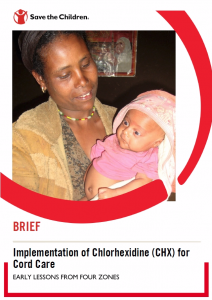
Approximately 3 million babies are born in Ethiopia each year, around 74 percent of them at home. The 2016 Ethiopia Demographic and Health Survey reported a newborn mortality rate of 29 per 1,000 live births, a rate that has stayed steady over the past 10–15 years1. Newborn mortality accounts for 43 percent of all under-five mortality. To help reduce newborn deaths, the Government of Ethiopia is implementing community-based newborn care (CBNC), including chlorhexidine (CHX) for infection prevention.
Severe infection is one of the top three causes of newborn deaths in Ethiopia.2 Ensuring optimal cord care at birth and during the first week of life, including use of CHX, especially in settings having poor hygiene, is a crucial strategy to prevent life-threatening sepsis and cord infections and avert preventable neonatal deaths. The national strategy for newborn and child survival has identified CHX for cord care as one of the 34 high-impact interventions to address the country’s high neonatal mortality rate (FMOH, 2015–2020). (FMOH) piloted the introduction of CHX cord care in four zones (East Gojam in Amahara region, East Shoa in Oromia region, Gurage in SNNPR and East Tigray in Tigray region) in the four agrarian regions of the country.
This synthesis report brings together key findings, programmatic as well as operational challenges, and recommendations for the scale up of CHX at national level. Additional information on these studies, including methods and results, will be published in the Ethiopia CBNC supplement in the Ethiopian Journal of Health Development (EJHD) in 2017.
-
Central Statistical Agency (CSA) [Ethiopia] and ICF. 2016. Ethiopia Demographic and Health Survey 2016: Key Indicators Report. Addis Ababa, Ethiopia, and Rockville, Maryland, USA. CSA and ICF.
-
Bulletin of the World Health Organization 2015;93:19-28. doi: http://dx.doi.org/10.2471/BLT.14.139790